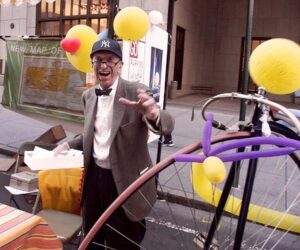Veteran, lawyer, native and guardian of Park Slope, defender of Prospect and Central Parks, and a charming citizen activist — those are just a few of the ways to describe Robert Makla, a truly influential figure in our community, who passed away on Oct. 14, 2010.

In honor of his dedication to Park Slope and Prospect Park, the Park Slope Civic Council has purchased a sapling in the park’s Woodlands restoration area. This memorial was made possible by the generous donation of Dino Veronese, a longtime resident of the community.
Robert Makla was born at the then-Methodist Hospital in 1926, in what would eventually be called Brownstone Brooklyn. He cherished growing up in his shire by the park. Robert served his country in World War II and the Korean conflict. Each time his service ended, he returned to his beloved Slope. A graduate of Princeton University and Yale Law School, Robert was an active partner in the law firm of D’Amato and Lynch, located in the Cities Service Building at 70 Pine Street in lower Manhattan.
Shortly after his return from Korea, Robert also became a trustee of the South Brooklyn Board of Trade. In the decade of the 1950s, social changes were starting to show themselves all through south Brooklyn. The rise of the baby boomers was changing the face of the housing supply in the area. These younger couples often wanted a yard, a driveway, and a more modern house, and they saw the improvement of the Long Island Railroad and the construction of roads throughout Nassau and Suffolk counties. A man by the name of Leffert was building what was extremely affordable housing in that area. Eyes turned to the east, and the migration from Brownstone Brooklyn was on.
As the middle class moved away, some parts of the brownstone area were left behind, and eventually looked like inner-city destruction zones. The Park Slope neighborhood came to be known as “Park Slop.” On Dec. 16, 1960, a jet plane crashed in the North Slope, on Sterling Place and Seventh Avenue. A newspaper report of the time told of a “plane crash in a rundown section of Brooklyn, by a park.”
By early 1960, Robert wanted to see his community return to its former grandeur. It was then that he convinced the South Brooklyn Board of Trade to change its name to the Park Slope Civic Council. Not only would the move make the board more of a civic organization, rather than a merchant-centralized society, but it would also mark a new beginning for the Park Slope area.
As the Civic Council evolved, Robert and his immediate successors took on immense social and civic problems, and developed new ideas to help in the community. Many of these problems were addressed during the period of 1960–69, laying the groundwork for a rebirth of the Slope. Among the achievements of this decade were:
- Creation of the Civic Council’s house tours, to show what the Slope once looked like and should look like again.
- New tree plantings, allowing for the return of shrubbery throughout the Slope.
- Formation of individual block associations.
- Input from the Council’s Education Committee to help in the building of P.S. 321, which replaced P.S. 71.
- Work with local churches, such as St. Augustine, to create shelters for the homeless and for battered women.
- Efforts to fight “redlining” in Park Slope, a practice in which banks would not provide home mortgages for undesirable community.
- Work to expose the block-busting techniques used by racist real-estate people, whose goal was to frighten people to leave the area.
- “Watchdog” for the changes in city zoning laws, which could have removed building restrictions to create larger building areas. Some real-estate interests, for example, looked at the Park Slope branch of the Brooklyn Public Library and Manual Training High School (now the Secondary Schools for Law, Journalism, and Research) as building sites, a move that the Civic Council helped prevent.
- Preservation of Robert’s beloved Prospect Park. Among the areas of the park restored was the Vale of Cashmere, a lovely fountain located close to Grand Army Plaza and a favorite spot of Robert’s. Elsewhere in the park, the Boathouse was saved from destruction, as was the Flatbush Avenue entrance to the park; a planned parking lot was stopped in the area between Eighth and Ninth Streets where the Prospect Park Botanical Garden had been ,; and the Prospect Park Zoo was preserved and not turned into a commercially sponsored small animal farm. The Council also fought plans of Robert Moses to change the overall condition of Prospect Park.
Work on these issues would continue well into the late 1970s and the start of the next rebirth of Park Slope.
In that decade, Robert became more involved in Prospect Park and other green spaces in the city. He and others created the Greensward Foundation, which would fight the changes that were being planned for city parks. He furthered that effort with the creation of a Friends of Park groups. The Friends would be for individual parks, such as Friends of Prospect Park, Central Park, and a multitude of public parks within the greater metropolitan area and beyond. There was not a park that Robert did not love.
Robert was, for a time, the voice of protection for Prospect Park, before the arrival of Tupper Thomas in 1980 and the creation of the Prospect Park Alliance in 1987. Robert now had the reinforcements to help save his beloved park.
Craig Hammerman, district manager of Community Board 6, may have summed up Robert’s feelings about parks best: “Parks are special places, where people of all races, incomes, and interests mix. They reconnect people to nature. Once park space is gone, it is not so easily replaced. [Robert believed] it is the job of every citizen to defend, preserve, and care for the wonderful green and open spaces throughout our city.”
Thank you, Robert, for your help in saving a whole neighborhood: our beloved Park Slope.
— Tom Miskel is a current trustee and past president of the Park Slope Civic Council.
For other remembrances of Robert Makla, please visit the Prospect Park Alliance website and the Save the Slope, Brooklynian, and Gothamist blogs. More information on planting a commemorative tree in Prospect Park can be found here.
from the December 2010 Civic News

